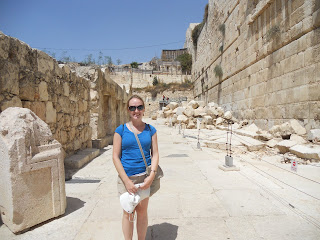Thursday we toured the property of the Passionist Priests’ house next to ours, and the Sisters of Charity next to them. The houses are built on land that used to be part of ancient Bethany. They have a fantastic 1st century Jewish Mikveh, the most complete one we have seen. It is the ritual bath in which Jews purified themselves after touching something “unclean” or before going to the temple, etc. This one in Bethany is important because Bethany was the last stop on the pilgrimage route from Galilee to Jerusalem, so many pilgrims would have stopped there to purify themselves before going on to the city. Jesus would have stopped here to purify himself, especially since he stayed with Mary and Martha in Bethany while visiting Jerusalem. There have only been two other mikveh’s found in the area, one dating from a later period, so this has a really good chance of being one used by Jesus. There are two sets of steps, one “unclean” set to go down, and another “clean” set to come back up after bathing. It was neat to see the graffiti inside the mikveh from when they re-plastered the walls and from the crusaders.
 |
| The entrance to the Mikveh |
Saturday was a really neat day. We walked along the pilgrimage route between Jerusalem and Jericho, which was the path Jesus and the disciples would have taken from Galilee. It goes through the Judean wilderness, which basically means the desert. It is also the area along the Jordan River where Jesus went for 40 days after being baptized by John and was tempted by Satan. I have no idea how he lasted 40 days because we barely lasted the 5 hours it took us to walk through. And unfortunately we did it in the heat of the day! It was about 104 degrees and we were hiking through the wilderness. We were sweating out water faster than we could drink it. I’ve never been so sweaty in my life. The path is through the Wadi Qelt. A wadi is a dry river bed, and you could see where water carved the rocks, but there hasn’t been water here in decades, maybe centuries.
We started on a paved road that led to the monastery of St. George. I have no idea how these monks get these crazy ideas to build monasteries in the most difficult places possible, but there it was. Along this road there were many Bedouin men offering their donkeys and camels as taxis! Then we walked down into the canyon and past the monastery and continued our journey in a single file line along a narrow path on the side of the cliff. It was really beautiful. When we could finally see the oasis of Jericho in the distance we cheered! It was a really neat experience. Not only do I have a deeper appreciation for Jesus’ temptation in the desert (I’m sure many in our group would have traded their first born child for a cold bottle of water), but also for the passage in Isaiah that announces the coming of God where the way will be made straight and every valley shall be exalted and every mountain made low. How amazing that would have sounded when you are used to walking in terrain like this! If we had a straight path we could have cut out time in half!
We started on a paved road that led to the monastery of St. George. I have no idea how these monks get these crazy ideas to build monasteries in the most difficult places possible, but there it was. Along this road there were many Bedouin men offering their donkeys and camels as taxis! Then we walked down into the canyon and past the monastery and continued our journey in a single file line along a narrow path on the side of the cliff. It was really beautiful. When we could finally see the oasis of Jericho in the distance we cheered! It was a really neat experience. Not only do I have a deeper appreciation for Jesus’ temptation in the desert (I’m sure many in our group would have traded their first born child for a cold bottle of water), but also for the passage in Isaiah that announces the coming of God where the way will be made straight and every valley shall be exalted and every mountain made low. How amazing that would have sounded when you are used to walking in terrain like this! If we had a straight path we could have cut out time in half!
 |
| The beginning of our hike |
 |
| Monastery of St. George |
Monday we had Easter Mass in the Church of the Holy Sepulcher where Jesus’ tomb is. It was really nice! Then some of us walked around town and did some shopping which was nice. Today we did the same. We are getting down to the end of our time here in Jerusalem, so we are making sure that we spend all of our shekels and get all of the souvenirs we have been eyeing over the past weeks. Tomorrow we go to the Dead Sea and surrounding area for two days. Then we come back and have a few retreat days, then it is on to Jordan and Egypt! 3 weeks from tomorrow I will be on a flight home. I cant believe it!



















































